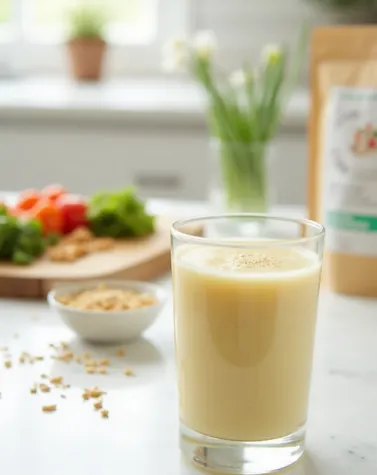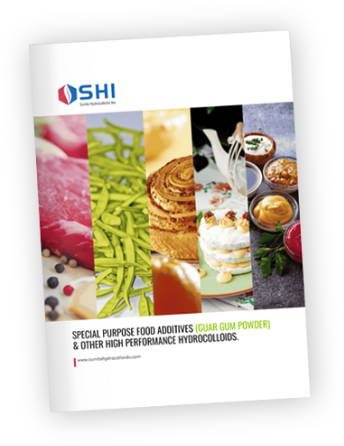
Guar Gum vs Gum Arabic: Key Differences and Best Uses Explained
When it comes to the use of food additives, guar gum and gum arabic are two of the most widely used natural thickeners. These plant based gums help food manufacturers improve texture, stability and shelf life across a range of products – from beverages to baked goods.
Guar gum and gum arabic have similar functions. However, they differ in origin, chemical structure and best use scenarios. Guar gum is derived from the guar bean (seeds) and is primarily cultivated in the arid regions of India and Pakistan. On the other hand, gum arabic is derived from the sap of the acacia tree, which is predominantly found in Africa.
In this post, we compare these two powerful thickening agents, helping food professionals and health conscious consumers understand when and how to use each.
Guar Gum and Gum Arabic – Natural Thickeners
Natural thickening agents are the food additives used to achieve the ideal mouthfeel and consistency in processed foods.
- Guar Gum: Often used in gluten free recipes, ice creams and dairy products, guar gum is highly soluble in cold water. It is well known to provide high viscosity even at low concentrations and is recognized for its ability to form a gel like consistency.
- Gum Arabic: Also called acacia gum, this ingredient is highly soluble and blends well into beverages, confectionery and glazes for nuts. It’s prized for its emulsifying and film forming abilities.
Other natural gums such as Xanthan gum (frequently used in salad dressings and sauces), locust bean gum and tara gum are often used in combination with other thickeners to modify gelling behavior or stabilize emulsions.
Gum Arabic Properties and Uses
Gum arabic is great for those food applications in which low viscosity, clarity and stability are needed.
- In soft drinks and almond milk, it is a stabilizer that prevents ingredients from separating.
- In ice creams, it helps control ice crystal growth, leading to a smooth texture.
- As a soluble fiber, gum arabic is generally well tolerated by the body in large amounts and contributes to dietary fiber intake.
- The emulsifying and binding properties of arabic gum make it ideal for gluten free baking, yogurts and sauces.
Due to its mild flavor and high solubility, gum arabic is commonly used in low calorie and functional foods.
Guar Gum Properties and Uses
Guar Gum is well known for its ability to create high viscosity. This means it can significantly thicken liquids even at very low quantities.
- In dairy products like ice cream and yogurts and baked goods, it improves texture.
- In sauces and dressings, it helps reach the desired texture and consistency.
- Due to its high solubility in cold water, guar gum is easily utilized in various formulations without the need for heat.
- When hydrated, guar gum forms opaque solutions. It displays excellent stabilizing and thickening properties.
- Guar gum prevents separation in many food systems. Its strong water binding capacity makes it a valuable texture agent.
Common applications for guar gum span across the food industry. Beyond food, it is a crucial component in the oil and gas industry and it is also used in textiles.
Guar Gum vs Gum Arabic – A Comparison
Here’s how guar gum and gum arabic differ.
| Property | Guar Gum | Gum Arabic |
| Source | Guar beans (Cyamopsis tetragonoloba) | Acacia tree sap |
| Viscosity | High | Low to moderate |
| Solubility | Disperses, forms gel | Highly soluble, no gel |
| Best in | Baked goods, dairy, gluten free | Beverages, coatings, candies |
| Fiber Type | Galactomannan (insoluble) | Arabinogalactan (soluble) |
| Allergen Risk | Generally safe | Generally safe |
| Price | Cost-Effective | Expensive |
| Quantity Usage | Low concentrations | High concentrations |
Guar gum is better suited for thick, gel like products like puddings, yogurt or gluten free doughs. On the other hand, gum arabic excels in clear beverages, spray dried flavors and candy coatings.
Choosing the Right Gum: Best Uses and Application Considerations
Deciding between guar gum and gum arabic requires a clear understanding of your product’s needs. Both guar gum and gum arabic offer significant advantages in food processing such as:
- Improvement in texture and mouthfeel
- Extended shelf life
- Stabilized emulsions and suspensions
- More fiber content and nutritional profile
- Less sugar and fat formulations
- Being vegan and gelatin alternatives
They are also used beyond food – in pharmaceuticals, cosmetics and dietary supplements.
When to Choose Guar Gum
Pick guar gum when high thickening is needed such as in sauces, soups or gravies and opacity is wanted such as in ice cream, yogurts or baked goods. It is best suitable for price sensitive applications as it is cost effective and a popular choice in gluten free products such as breads and pastries.
When to Choose Gum Arabic
Opt for gum arabic when you need to stabilize oil in water emulsions such as in salad dressings or flavor emulsions. It is an encapsulating agent, ideal for beverages, clear candies or coatings and is preferred when transparency and minimal thickening are needed. It is a popular choice in confectionery applications as it prevents sugar crystallization in candies and chewing gum.
Sometimes, guar gum and arabic gum are also used together to achieve a synergistic effect, combining their unique strengths for complex formulations.
Conclusion
The modern consumers read labels and prefer to consume plant based gums in their food. Both guar gum and gum arabic are exceptional natural hydrocolloids — but their ideal uses depend on the specific needs of your application. Use guar gum for thicker, gel like textures and high viscosity needs.
Choose gum arabic for beverages, fiber enrichment and emulsification. Also, keep in mind that moderation is key. While generally safe, excessive inclusion of any thickener in the diet may lead to digestion discomfort for some individuals.
By understanding the properties and differences in guar gum and arabic gum, food developers and health conscious consumers can confidently integrate these two hydocolloids into a variety of innovative and functional food products.





